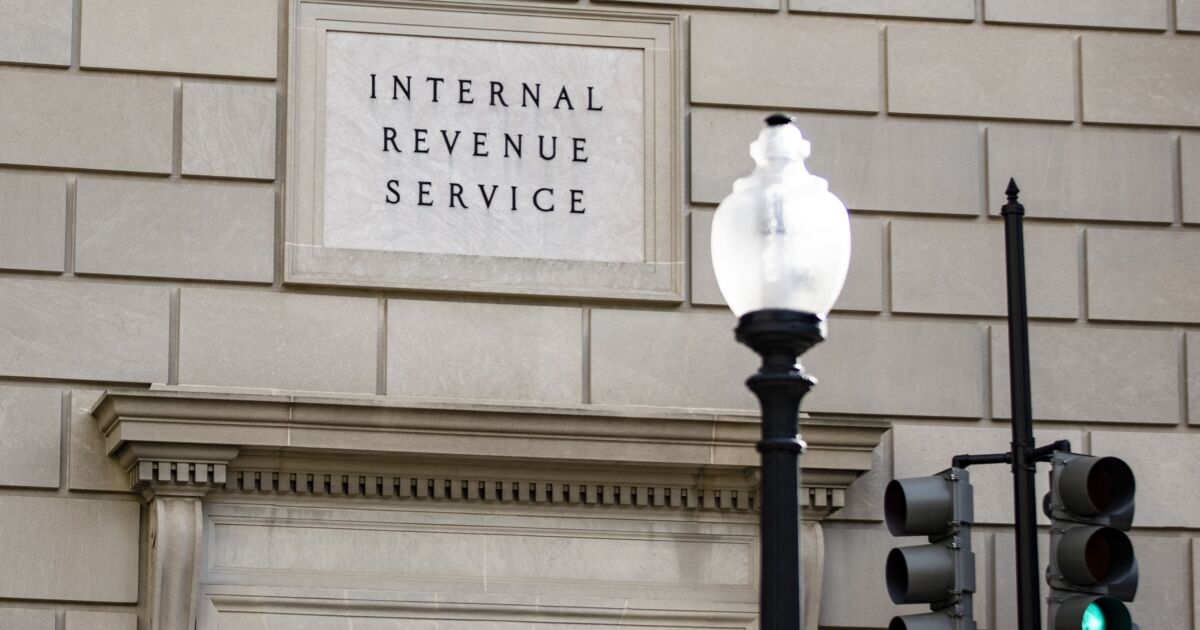Accounting
Wall Street rush to launch Vanguard-style funds draws warnings
Published
1 day agoon


Exchange-traded funds have amassed trillions of dollars by offering investors greater tax efficiency, liquidity and lower costs than mutual funds. Now, a looming
The Securities and Exchange Commission is expected to approve
The two-in-one blueprint is a tantalizing prospect for asset managers looking to break into the ETF market at scale, without having to launch a new strategy from scratch. It also offers a lifeline to firms battered by years of mutual-fund outflows, as investors fled for more tax-efficient alternatives. The hybrid structure famously helped Vanguard save its clients
Yet replicating that playbook may prove harder than it looks. Some Wall Street experts caution the shake-up could erode key benefits of the wrapper, especially if hybrid funds face significant withdrawals during market stress.
“I’ve been in the ETF business for 20 years — we have spent it talking about how great they are at managing capital gains, and I don’t think folks have an appreciation for how more ETFs could potentially end up paying capital gains distributions,” said Brandon Clark, director of ETF business at Federated Hermes, who previously led the ETF capital markets team at Vanguard.
At the heart of the concern is a tax dynamic that ETFs were built to avoid. These funds rarely pay capital-gains tax distributions, thanks to their in-kind redemption process, which allows the issuer to swap securities with authorized participants rather than sell them outright.
By contrast, mutual funds redeem in cash, meaning managers may need to sell securities to meet outflows. If those sales generate capital gains, they may distribute them to investors. In a hybrid vehicle, those taxable gains risk getting passed onto ETF shareholders, too.
“For mutual funds drawing inflows or net zero flows, there should be no issues, but for ones with outflows, there’s a potential risk for the ETF holders,” said Bloomberg Intelligence senior ETF analyst Eric Balchunas, in a note.
About two-thirds of ETF issuers surveyed by consulting firm Cerulli Associates flagged this spillover issue. There’s precedent. In 2009, a Vanguard fund distributed a 14% capital gain across both share classes, after a large mutual-fund withdrawal, Bloomberg data show. Though rare, the episode underscores the fiscal complications in the event a fund experiences outsized outflows within a shared portfolio.
“The investors that stand to benefit most immediately are the ones that already own the fund, as it can only improve the fund’s tax efficiency,” said Ben Johnson, head of client solutions at Morningstar Inc.
Wirehouses like UBS Group Inc., which list funds for financial advisers, are studying how this would impact which funds they will offer on their platforms.
An ETF share class could “run the risk of receiving tax distributions they otherwise wouldn’t have,” said Mustafa Osman, who runs due diligence on funds before they are added to the platform as head of ETF and mutual fund strategy and analytics at UBS.
The SEC refers to this issue as “cross-subsidization” and has directed applicants to detail how they’ll mitigate it. In response, firms like Dimensional Fund Advisors have amended their applications to detail a governance structure where the fund works with its independent board to determine if the dual structure is beneficial to both shareholders, while monitoring risks like cross-subsidization before and after launch. Among issues that would be considered: cash levels, unrealized gains and losses, and turnover.
Even standalone ETFs are paying out more capital gains more frequently these days, as more products track derivatives or assets that have risen markedly in value. In 2024, roughly 5% of passive ETFs paid out capital gains, the most since 2021, and 12% of active ones did, the highest since 2022, data compiled by Bloomberg show. Those figures are much larger for mutual funds, of course, with more than 50% paying them out last year.
Another complication lies in how the structure would impact the economics of ETF listings on big-name platforms. Cerulli estimates wirehouses and broker-dealer platforms could lose as much as $30 billion in revenue if mutual fund assets shift to ETF share classes in droves.
To stem the loss of revenue, intermediaries could begin to introduce
“This trend of trying to recapture some of that revenue that’s been slowly melting from the mutual funds has been in place for ETFs for the last few years,” said Ben Slavin, global head of ETFs at BNY.
Beyond fees and tax advantages, ETFs famously offer more liquidity than mutual funds — a selling point that may be undermined in some instances, if the two models are combined. According to Cerulli, ETFs that struggle to scale could see wider bid-ask spreads, with costs ultimately passed onto investors.
All told, this is uncharted territory. Vanguard’s success relied on stable flows, deep relationships with market makers and highly liquid portfolios. Large firms may be able to follow suit smoothly, but smaller managers holding less liquid assets could find the road ahead trickier.
“It’s not evident that authorized participants are ready for a plethora of smaller ETFs as a share class exposures, especially outside the most liquid underlying markets,” Cerulli researchers wrote in a report.
You may like

Pardon us; no relief in sight; down on the farm; and other highlights of recent tax cases.
San Francisco: Winery co-owner Brian Fleury, 64, of Napa County, California, has pleaded guilty to aiding and assisting the preparation of a false return.
Fleury and his spouse owned the winery Metropolitan Wines and several vineyards in Napa Valley. For tax years 2014 through 2018, Fleury underreported Metropolitan’s income to his tax preparer. Fleury directed some customers to pay with checks directly to Fleury instead of to Metropolitan and wrote or told his employees to “off the books,” on some of these customers’ invoices. Fleury kept these payments for himself and did not report this as income.
Between 2014 and 2018, he underreported his and his spouse’s income by $822,450.
Fleury also admitted that from 2007 through 2019, he failed to pay federal excise tax that was due on brandy he received, possessed and sold, filing annual reports with the U.S. Department of the Treasury, Alcohol and Tobacco Tax and Trade Bureau that he knew were false.
In total, he caused a tax loss to the IRS and TTB of $211,092.
Washington, D.C.: President Trump has pardoned Paul Walczak of Palm Beach Gardens, Florida, two weeks after Walczak’s
Walczak, who was convicted of evading more than $10.9 million in payroll taxes and sentenced to 18 months in prison and two years of supervised release, controlled a network of interconnected health care companies operating under various names, employing more than 600 people.
In 2011, Walczak did not pay two quarters of withheld taxes to the IRS. He evaded collection efforts and continued not paying over taxes from employees’ paychecks and keeping the money to fund what authorities called a lavish lifestyle, including the purchase of a yacht.
He caused a total federal tax loss of $10,912,334.80 and was also ordered to pay $4,381,265.76 in restitution.
Walczak is the son of Betsy Fago, a longtime Republican donor who recently attended a Trump fundraising dinner,
Trump was slated to pardon reality show stars
Athens, Georgia: Tax preparer Jessica Crawford, 34, who previously
FBI agents investigating a multistate unemployment benefit scheme that was conducted during the pandemic discovered texts between conspirators and Crawford, a preparer with Crawford Tax Services. Crawford filed for PUA benefits on behalf of those individuals who had created fake businesses or submitted false information to steal benefits. In return, she received a percentage of the gains.
In 2022, an undercover IRS agent met Crawford to have their taxes prepared, and Crawford asked if the agent did anything on the side. At first the agent said no; Crawford replied that expenses could be deducted. The agent said he sometimes mowed an aunt’s lawn but provided no income or expense amounts. Crawford created a Schedule C business for landscaping on the agent’s federal return and prepared a 1040 and a fictitious Schedule C loss of $19,373, as well as claimed an Earned Income Tax Credit, a Child Tax Credit and a qualified business income deduction. As a result, the agent’s return claimed a fraudulent federal income tax refund of $12,359.
The IRS reviewed 1,261 returns filed by Crawford in tax years 2020 and 2021 and determined that she fraudulently filed returns on behalf of clients, resulting in losses to the IRS exceeding $3 million from false 7202 credits for sick leave and family leave, tax credits and dependent care credits.

Marina Del Rey, California: Elana Cohen-Roth, 81, a retired IRS agent, has been sentenced to 12 years in prison after being convicted of 23 felony offenses related to defrauding an elderly victim of her life savings.
Cohen-Roth exploited a professional and personal relationship she’d had with an elderly area resident. A retired IRS agent and professional tax preparer, Cohen-Roth began preparing the then 66-year-old victim’s taxes in 2013. From their friendship, Cohen-Roth gained access to all the victim’s financial information. Cohen-Roth told the victim she would invest in some type of real estate to earn at least 10% at “no risk.”
From December 2013 through September 2019, Cohen-Roth extended “investment opportunities” to the victim on more than 20 occasions in amounts from $25,000 to $150,000. Each time, the victim took money from her legitimate investments and wired it to Cohen-Roth.
Bank records revealed that Cohen-Roth was running a Ponzi scheme where other investors also deposited large sums into her account. Cohen-Roth used some of the elderly victim’s money to pay off these earlier investors and used the rest to support her lavish lifestyle and make gifts to family members.
By September of 2019, the victim had depleted her investment accounts and took out a reverse mortgage to send additional money to Cohen-Roth. The scheme collapsed in 2020 when the victim demanded a return of some of her money so that she could move near her family. Cohen-Roth did not have another source to repay the victim, who did not receive any of her money back.
A jury convicted Cohen-Roth of all 23 felony financial fraud charges. Because of her age, she was sentenced to the middle term of 12 years in state prison rather than the maximum of 28 years.
Richmond, Virginia: Tax preparer Baltej Singh Brar, 42, of South Richmond Hill, New York, has been sentenced to two years in prison for making false statements on loan applications he submitted for clients through pandemic relief.
Brar owned and operated Aspire Tax & Accounting Services and in 2021 began filing loan applications on behalf of other individuals through the Paycheck Protection Program. He advertised that he would file loan applications in exchange for an upfront fee and 10% of the loan value after approval.
Brar instructed prospective applicants to provide him with their Social Security numbers, a copy of their driver’s license, email address, prior bank statements, their 2019 return and a voided check to be used as supporting documentation. Most of Brar’s clients were sole proprietors, including taxi drivers, truck drivers and construction workers. Where clients’ prior year incomes fell below the threshold to receive the maximum PPP loan of $20,833, Brar inflated the income amounts in the applications. Brar caused the Small Business Administration at least $550,000 in losses.
Greensburg, Pennsylvania: Accountant Jonathan A. Weston, a resident of Canonsburg, Pennsylvania, has been sentenced to 27 months in prison and ordered to pay more than $8 million in restitution after being convicted of fraud conspiracy, conspiracy to commit money laundering and filing false income tax returns.
From October 2005 to January 2019, Weston, an accountant for Hillandale Farms Co., schemed with another employee to embezzle some $6.8 million from the company and launder the money through businesses they both controlled to buy collectible cars, real estate and other items.
Between 2013 and 2018, Weston also either failed to file or filed false federal personal income tax returns, including filing a false return in which he underreported more than $500,000 stolen from Hillandale.
He was ordered to pay $6,870,128 in restitution to Hillandale Farms and $1,216,176 to the IRS. He was also ordered to forfeit assets from his crime, including a 2008 Aston Martin, a 1933 Ford Model 40 Coupe and a condominium.
Accounting
Counties with highest capital gains per 2025 study
Published
43 minutes agoon
May 29, 2025

The more value that investors can receive in the form of long-term capital gains rather than ordinary income, the less they will pay back to Uncle Sam.
Those in the 20 counties below ranked by the average net capital gains reported on their federal returns to the IRS are getting above-average appreciation on their assets with much lower tax rates, generally, than their incoming income,
For financial advisors and their clients, the list provided
“Net capital gains represent the profits a taxpayer recognizes from selling a capital asset after offsetting capital losses. These gains are often created by highly appreciated assets,” Kathy Buchs, a senior tax advisor, team leader and managing director with Cleveland, Ohio-based registered investment advisory firm
“We take geography into account when advising clients to sell an asset or consider tax loss harvesting due to
That difference in tax rules at the state level raises the possibility of strategies such as an incomplete gift non-grantor trust that, in some areas, could “eliminate the state taxation of the trust-owned portfolio,” said Richard Austin, an executive director for estate and business planning with San Diego and Waltham, Massachusetts-based RIA firm
“Tax efficiency significantly impacts the performance of a client’s portfolio by maximizing the after-tax return on investments,” Austin said. “Investing across different countries and regions can reduce portfolio volatility. Markets in different parts of the world often have low correlation, meaning they don’t always move in the same direction at the same time. If one market experiences a downturn, others might perform well, potentially stabilizing overall returns and the potential for future capital gains. State-specific tax rates impact tax efficiency of a portfolio. The difference in state income taxes creates a significant layer of complexity in achieving tax efficiency for a client’s portfolio.”
Even though any type of data presents the possibility of noise factors affecting any particular region, the study “highlights that taking geography into account is essential when advising clients on their asset allocations,” said Michelle Ash, a senior wealth advisor with the Jacksonville, Florida-based office of RIA firm
“Net capital gains is measured when a person is selling assets, and so it requires past investment success to be in that position,” Ash said in an email. “It’s no surprise to me that Florida would be the top state by this metric. Florida has no state income, inheritance or estate taxes, and so it’s a beneficial place to live when you’re selling assets. These Florida traits also attract a lot of retiring individuals who may be selling assets like homes and businesses when they retire or move.”
In focusing on capital gains, SmartAsset sought to home in on the areas where investors netted the most gains with preferential rates compared to ordinary income, according to the report’s author, SmartAsset Director of Economic Analysis Jaclyn DeJohn.
“Net capital gains, the profits from selling assets like stocks, real estate or businesses, are a key measure of investment success
Besides the listing below, here are some of the other interesting takeaways from the study:
- Three Georgia counties, Chattahoochee, Quitman and Taliaferro, displayed the smallest average net capital gains, at $2,400 or less. Fewer than 10% of returns in the counties had net capital gains.
- At the state level, West Virginia tax returns had the lowest average net capital gains at $14,612, followed by Wisconsin with $19,590 and Iowa with $20,220.
- On the other end of the spectrum among the states, federal returns out of Florida ($84,911), Wyoming ($84,246), Nevada ($77,491), the District of Columbia ($58,733) and Texas ($52,926) reported the highest average net capital gains.
Scroll down the slideshow for the ranking of the top 20 counties in the U.S. in terms of average net capital gains. To see a list of the top 10 cities with the highest income among retirees,
Note: The below rankings are based on a report by SmartAsset called, “
Accounting
IRS faces challenges overseeing tax-exempt hospitals
Published
1 hour agoon
May 29, 2025

The Internal Revenue Service has been facing
The
Other factors, including whether a hospital provides financial assistance to those unable to pay, are relevant in determining whether a hospital is providing a benefit to the community, the report noted. However, the Internal Revenue Code doesn’t specify what eligibility criteria or level of assistance provided is considered to be adequate for a financial assistance policy to meet the statutory requirements. “Vague or unclear eligibility criteria could potentially cause confusion for patients and inconsistent application of the requirements across hospitals,” said the report.
In April 2022, the IRS revised the scope of its CBARs to focus only on the Affordable Care Act’s statutorily required community benefit standard. As a result, examination referrals dropped 98% from fiscal years 2022 through 2024.
To address the reduced amount of oversight due to the streamlined CBAR process, the IRS implemented a compliance strategy that aimed to identify potential noncompliance by tax-exempt hospitals. Using the IRS’s data, TIGTA did an analysis of the available filing information to identify tax-exempt hospitals potentially subject to the CBARs and compared it to the IRS’s population of tax-exempt hospitals. TIGTA identified 142 missing tax-exempt hospitals that the IRS should have included in its population but weren’t identified or reviewed. In addition, the IRS excluded 14 governmental unit and 13 church-affiliated hospitals from the population for other reasons.
TIGTA made four recommendations in the report, suggesting the Treasury Department’s Office of Tax Policy consider a legislative proposal to amend Section 501 of the Internal Revenue Code and any other required provisions of law to define the community benefit standard and establish baseline criteria for tax-exempt hospital financial assistance policy eligibility. TIGTA also recommended the IRS should update its guidance to include reasons for excluding dual status governmental unit and certain church-affiliated hospitals from the CBARs because they are statutorily mandated. The IRS agreed with all four of TIGTA’s recommendations and plans to implement corrective actions.
“The IRS appreciates TIGTA’s analysis and the opportunity to consider improvements in the tax administration of tax-exempt hospitals,” wrote Robert Choi, acting commissioner of the IRS’s Tax-Exempt and Government Entities Division. He pointed out that the Government Accountability Office agreed with TIGTA that Congress should consider specifying in the Internal Revenue Code what services and activities it considers sufficient community benefit to improve the IRS’s ability to oversee tax-exempt hospitals.That would enable the IRS to issue updated regulations that provide more specific guidance.
However, the IRS will likely face difficulties given the

Tax Fraud Blotter: Side hustles

Stocks making the biggest moves after hours: GAP, AEO, PATH, DELL

Counties with highest capital gains per 2025 study

New 2023 K-1 instructions stir the CAMT pot for partnerships and corporations

The Essential Practice of Bank and Credit Card Statement Reconciliation

Are American progressives making themselves sad?
Trending
-

 Accounting1 week ago
Accounting1 week agoHouse tax bill includes provision eliminating PCAOB
-

 Economics1 week ago
Economics1 week agoWhat happens if the Inflation Reduction Act goes away?
-

 Personal Finance1 week ago
Personal Finance1 week agoWhat House Republican ‘big beautiful’ budget bill means for your money
-

 Accounting1 week ago
Accounting1 week agoTrump tax bill faces Senate’s arcane rules, desire for changes
-

 Finance6 days ago
Finance6 days agoPersonal finance app Monarch raises $75 million
-

 Economics1 week ago
Economics1 week agoA court resurrects the United States Institute of Peace
-

 Economics1 week ago
Economics1 week agoHow much worse could America’s measles outbreak get?
-

 Economics1 week ago
Economics1 week agoCalifornia has got really good at building giant batteries
